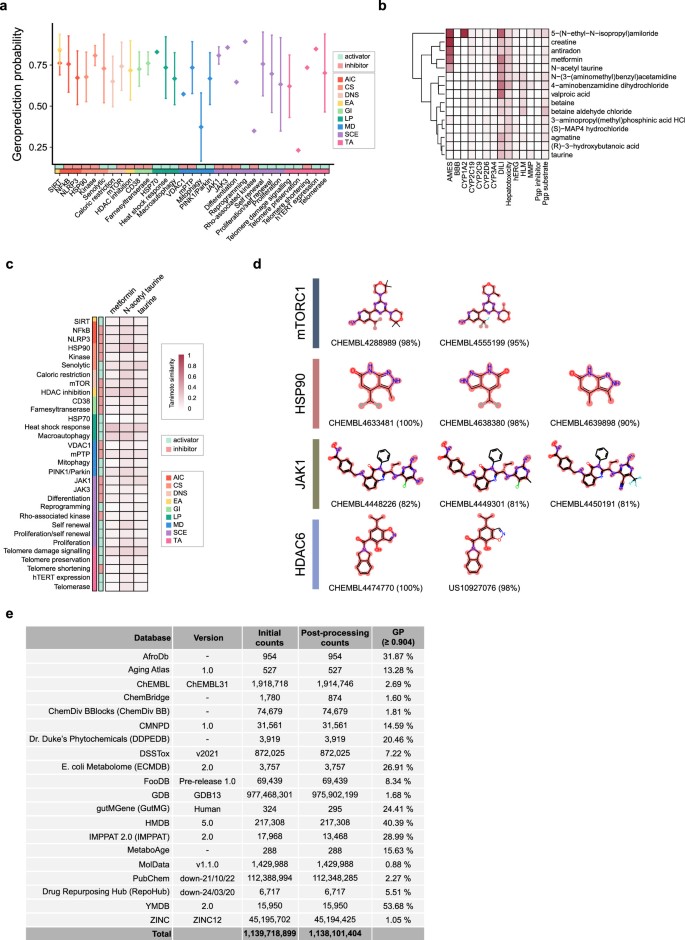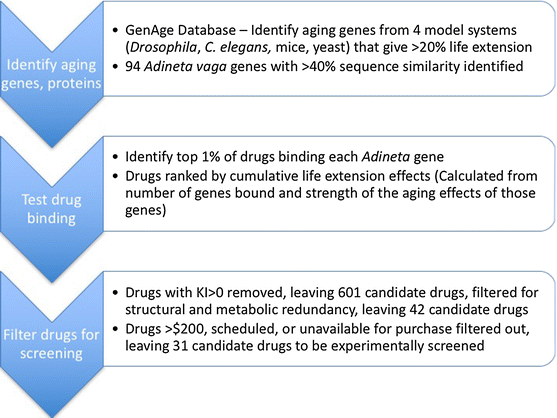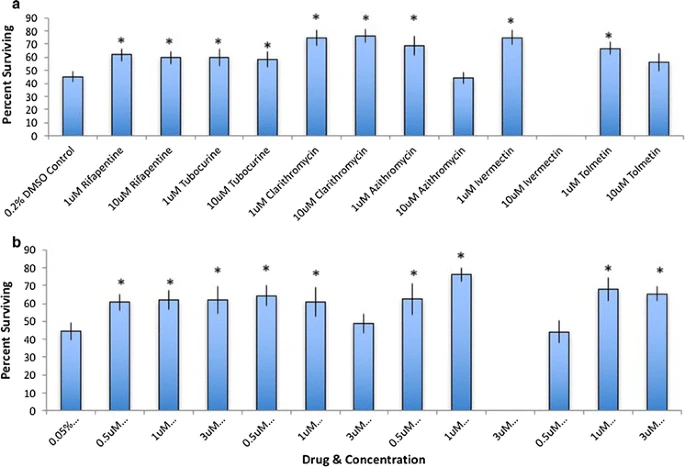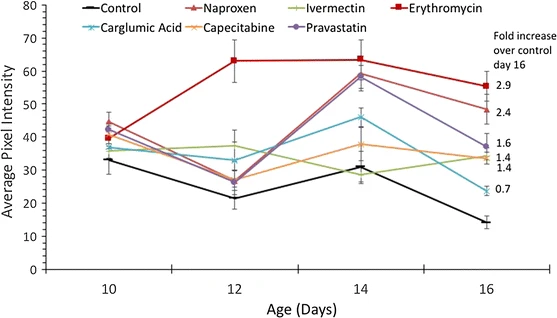 Forum für Lebensverlängerung
»
Radikale Lebensverlängerung, Sport, Verschiedenes
»
Radikale Lebensverlängerung
»
Geroprotektoren
Forum für Lebensverlängerung
»
Radikale Lebensverlängerung, Sport, Verschiedenes
»
Radikale Lebensverlängerung
»
Geroprotektoren


|
|
Geroprotektoren sind Substanzen, die den Alterungsprozess verlangsamen.
Nebenkriterien Sortiert man mit diesem Algorithmus unter den bekannten Geroprotektoren, ragen folgende Substanzen heraus, die in den Augen der Autoren großes Potential auch beim Menschen haben könnten: Zitat: Acarbose Acarbose is an α-glucosidase inhibitor used to treat diabetes mellitus. Treated with this compound, male UM-HET3 mice had 22% longer lifespan (Harrison et al., 2014). It has acceptable acute toxicity – mouse LD50 oral is 24 gm kg−1 (Tomasulo, 2002). Acarbose is considered to be well-tolerable drug with adverse effects not significantly differing from placebo (Hotta et al., 1993). Acarbose reduces blood glucose concentrations, blood pressure, triglycerides, the progression of intima media thickness, and incidence of cardiovascular events and of newly diagnosed hypertension, and it demonstrates beneficial effects on overweight individuals and downregulates biomarkers of low-grade inflammation (Hanefeld & Schaper, 2008). Deprenyl Deprenyl is a selective MAO-B inhibitor used to treat major depression and early-stage Parkinson disease. It prolongs lifespan in male rat (Kitani et al., 1993). No significant acute toxicological data for this compound were identified in literature search (mouse LD50 intraperitoneal 200 mg kg−1) (Kane et al., 1988). Deprenyl is also well tolerated (Robottom, 2011). Deprenyl protects human neurons from apoptosis induced by various kinds of insults by interfering with early apoptotic signaling events and may be applicable to delay the deterioration of neurons during advancing aging (Maruyama & Naoi, 1999; Magyar et al., 2004). D-glucosamine D-glucosamine is an amino sugar and a potent drug for the treatment of arthritis, although its effectiveness is controversial (Burdett & McNeil, 2012). Nevertheless, it is able to promote lifespan of nematodes and C57BL/6NRj mice (Weimer et al., 2014). This compound has very low acute toxicity and is safe for everyday use (Reginster et al., 2001). Current use of glucosamine was associated with a significant decreased risk of death from cancer (HR 0.87 95% CI 0.76-0.98) and with a large risk reduction for death from respiratory diseases (HR 0.59 95% CI 0.41-0.83) (Pocobelli et al., 2010; Bell et al., 2012). Glucosamine supplementation can significantly decrease risk of lung cancer in humans (Brasky et al., 2011). A meta-analysis has shown that glucosamine has lowest risk of adverse effects compared with other treatments (Diarecin and NSAIDs) (Kongtharvonskul et al., 2015). The oral supplementation of glucosamine can potentially improve cutaneous aging in human and reduce the appearance of visible wrinkles and fine lines of the skin (Murad & Tabibian, 2001). Dihydroergocristine methanesulfonate Dihydroergocristine methanesulfonate is an fungally derived alkaloid salt and a potent vasodilator (Valli et al., 1984). It is one of the 60 compounds identified in a screen for increased longevity in C. elegans (Ye et al., 2014). In two studies (Aranda et al., 1992; Milvio, 1992), dihydroergocristine was shown as safe and well tolerated with rare side effects including mild gastralgia, nausea, and dyspepsia in aged patients with senile dementia of Alzheimer type. Dihydroergocristine methanesulfonate in some studies has statistically significant positive effects on symptoms of age-related cognitive dysfunction (Wadworth & Chrisp, 1992). Ellagic acid Ellagic acid is a natural polyphenol found in numerous edible plants. Its ability to prolong C. elegans lifespan is proposed to be due to a hormetic effect (Saul et al., 2011). This substance has also low acute toxicity – rat LD50 oral > 20 gm kg−1 (Tomasulo, 2002). Study on rats showed a potentially good tolerability (Tasaki et al., 2008). Ellagic acid prevents collagen destruction and inflammatory responses caused by UV-B-induced photoaging in HaCaT keratinocytes and human dermal fibroblasts (Bae et al., 2010). Glutathione Glutathione is a tripeptide with notable antioxidant effect. Glutathione prevents aging-associated oxidation of proteins in the crystalline lens (Kamei, 1993).It is also able to promote C. elegans lifespan (Shibamura et al., 2009) and has rather low acute toxicity – mouse LD50 oral 5 gm kg−1 (Tomasulo, 2002). A recent study showed that glutathione was well tolerated with few side effects (Richie et al., 2015). Metformin Metformin is an oral antidiabetic drug of the biguanide class that is widely prescribed as an early-stage drug for type II diabetes. It enhances longevity is a range of model organisms: C. elegans (Cabreiro et al., 2013), D. melanogaster (Slack et al., 2012), and M. musculus (Martin-Montalvo et al., 2013). However, it should be noted that there are studies showing no effect or only a very small effect of metformin in rats and rodents with normal genetics and longevity (https://www.ncbi.nlm.nih.gov/pubmed/20304770, http://www.ncbi.nlm.nih.gov/pubmed/23900241). It has acceptable acute toxicity – mouse LD50 oral 1450 mg kg−1 (Tomasulo, 2002) – and is well tolerated (Giugliano et al., 1993). Serious but rare adverse effects include lactic acidosis (mostly linked to alcoholism due to depletion of NAD+ stores), heart failure, respiratory disease (due to inadequate oxygenation of tissues), and impaired renal function. Metformin treatment confers insulin sensitivity, leads to weight loss, and improves lipid profiles (Salpeter et al., 2008). Rapamycin Rapamycin is an antifungal agent with immunosuppressive and antiproliferative effects. It has a lifespan-prolonging effect in several studies on different model organisms, including S. cerevisiae (Powers et al., 2006; Medvedik et al., 2007), C. elegans (Robida-Stubbs et al., 2012), D. melanogaster (Moskalev & Shaposhnikov, 2010), and M. musculus (Harrison et al., 2009; Fok et al., 2014; Miller et al., 2014). It has acceptable acute toxicity – mouse LD50 oral > 2500 mg kg−1 (Vezina et al., 1975) – although it can induce a range of reversible but concerning side effects (Soefje et al., 2011). Other rapamycin derivatives (termed rapalogs) appear to have similar effects. A majority of reports also indicate that rapamycin delays pathologies of aging in mice and protects against age-related diseases, including cardiac and neurodegenerative syndromes, as well as neoplasms (Johnson et al., 2013; Lamming et al., 2013). Rapamycin also is reported to suppress nuclear defects in cells isolated from Hutchinson–Gilford progeria syndrome, although reports of the drug have not been reported in mouse models of the disease (Oyanagui, 1984; Pocobelli et al., 2010).67,68 Spermidine Spermidine is a natural polyamine compound found in animal tissues. It is reported to promote lifespan of yeast, flies, worms, human cells, and mice (Eisenberg et al., 2009). Spermidine has acceptable acute toxicity – mouse LD30 oral 1 gm kg−1 (Oyanagui, 1984). Administration of spermidine, whose intracellular concentration declines during human aging, markedly extends the lifespan of human immune cells. In aging human cells, spermidine treatment triggers epigenetic deacetylation of histone H3 through inhibition of histone acetyltransferases, enhances autophagic flux, and suppresses oxidative stress and necrosis (Eisenberg et al., 2009). Tyrosol Tyrosol is natural phenolic antioxidant, a derivative of phenethil alcohol. It is able to increase both mean and maximum lifespan in C. elegans (Canuelo et al., 2012) and is well tolerated (Tuck & Hayball, 2002). Tyrosol can afford considerable protection against aging-associated heart deterioration (Owen et al., 2000). Several studies showed a cardioprotective role of tyrosol (Samuel et al., 2008; Smol'iakova et al., 2010; Sun et al., 2015). Tyrosol's cardiovascular benefits are likely due to its ability to prevent oxidation of LDL (Covas et al., 2006; Castaner et al., 2012). Also, tyrosol ameliorated hyperglycemia by regulating key enzymes of carbohydrate metabolism in streptozotocin-induced diabetic rats (Chandramohan et al., 2015). A human study of tyrosol-rich products (white wine and virgin olive oil) demonstrated an anti-inflammatory effect (Migliori et al., 2015). Tyrosol has a potent anti-allergic effect by inhibiting the degranulation of mast cells and expression of inflammatory cytokines (Je et al., 2015). Tyrosol has very low acute toxicity (LD50 was found to be 2700 and 1700 mg kg−1 in mice after intragastric and intraperitoneal injection, respectively, and 7079 mg kg−1 in rats after intragastric administration). No toxicity was observed after 3 months of chronic intragastric administration of p-tyrosol at the doses of 200 mg kg−1 in male rats and 10 mg kg−1 in dogs (Saratikov & Krasnov, 2004). Vinpocetine Vinpocetine is a semisynthetic derivative of the alkaloid vincamine with nootropic effects. It is another of the 60 compounds identified in a recent screen for enhanced longevity in C. elegans (Ye et al., 2014). It has acceptable acute toxicity – mouse LD50 oral 534 mg kg−1 (Cholnoky & Domok, 1976). In an 18-month study, vinpocetine was reported safe and had a good tolerability during the whole study period (Valikovics et al., 2012). In another study, vinpocetine failed to show effectiveness in treatment Alzheimer disease, but there also were no significant side effects from drug therapy (Thal et al., 1989). Vinpocetine significantly inhibits in vitro aging of human erythrocytes (Bayer et al., 1988). Quelle: Developing criteria for evaluation of geroprotectors as a key stage toward translation to the clinic http://onlinelibrary.wiley.com/doi/10.1111/acel.12463/full Eine Datenbank mit bekannten Geroprotektoren findet sich hier: http://geroprotectors.org/ |

|
jayjay
(
gelöscht
)

|
Zur Acarbose: |

|
|
Acarbose ist zwar "nur" ein Zucker, ist aber in Deutschland verschreibungspflichtig und zur alleinigen Gewichtreduktion nicht zugelassen (= deine Partnerin bekommt kein Rezept). |

|
|
Für die meisten Geroprotektoren haben wir schon eigene Threads: |

|
jayjay
(
gelöscht
)

|
Danke Prometheus, |

|
|
Vielen dank für den Link Prometheus, mir war bisher der Ausdruck "Geroprotektor" nicht bekannt. |

|
|
Zitat von La_Croix im Beitrag #6 EGCG hat laut den in der Datenbank hinterlegten Studien eine Verlängerung der mittleren Lebenszeit um 10% beim Rundwurm und eine mediane Lebenszeitverlängerung von ca. 13% bei der Ratte gezeigt. Für eine "Top-Platzierung" reicht das wohl nicht. Für Theaflavin(e) gibt es aktuell nur wenig Daten zur Lebensverlängerung. Die einzige mir bekannte Studie ist mit Schwarzteeextrakt (Einer Mischung aus Theaflavinen und Epicatechinen) durchgeführt worden: Black tea theaflavins extend the lifespan of fruit flies http://www.sciencedirect.com/science/art...531556509001922 |

|
|
EGCG bzw. grüner Tee haben unbestreitbar viele Vorteile, die ja auch hier schon ausführlich besprochen wurden. |

|
|
Ein weiterer Gesichtspunkt:
Curious sagt danke
|

|
|
Ein Vorschlag zur Klassifikation von Geroprotektoren: |

|
|
The AI that could uncover the secret of eternal youth: Russian researchers reveal new tool to find life-extending drugs - and say it has already uncovered ten potential therapies Zitat
Prometheus sagt danke
|

|
|
Testing drug combinations to slow aging
La_Croix sagt danke
|

|
|
Gibt übrigens auch eine Übersicht über Radioprotektoren.
La_Croix und Prometheus haben sich bedankt!
|

|
|
Geroscience-guided repurposing of FDA-approved drugs to target aging: A proposed process and prioritization
CRONos sagt danke
|

|
|
Hatten wir hier noch nicht: Zitat
|

|
|
Astaxanthin and meclizine extend lifespan in UM-HET3 male mice; fisetin, SG1002 (hydrogen sulfide donor), dimethyl fumarate, mycophenolic acid, and 4-phenylbutyrate do not significantly affect lifespan in either sex at the doses and schedules used
CRONos und Prometheus haben sich bedankt!
|

|
|
Zitat von Speedy im Beitrag #18 Das besondere hier es profitieren nur männliche Mäuse wirklich. Haben wir ja zum Beispiel auch bei Acarbose so.
Prometheus sagt danke
|

|
Gelöschtes Mitglied

|
Vinpocetin und/oder Vincamin sollen laut anekdotischen Berichten angeblich die Wirksamkeit anderer Stoffe im Gehirn erhöhen können. Falls sich das bewahrheitet, hätte man evtl. einen brauchbaren Enhancer für andere Nootropika. Zitat
Zitat
Zitat
Zitat
Zitat
Tizian, Speedy und Prometheus haben sich bedankt!
|

|
|
Leider hinter einer Paywall.
Prometheus sagt danke
|

|
|
Zitat von Speedy im Beitrag #21 Ich komme auch nicht dran, aber dieses Bild hier im freien Preview führt einige der untersuchten Geroprotektoren auf:  |

 Thema drucken
Thema drucken 09.06.2016 22:46 (zuletzt bearbeitet: 09.06.2016 22:57)
09.06.2016 22:46 (zuletzt bearbeitet: 09.06.2016 22:57)

 Antworten
Antworten


